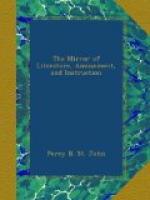Fraser’s Magazine.
* * * * *
THE NATURALIST.
* * * * *
NUTRIA FUR.
[We quote the following account of Nutria from the Dictionary of Commerce, by Mr. Macculloch, who believes it to be the first description that has appeared in any English work, and acknowledges it from the pen of J. Broderip, Esq., F.R.S., &c.]
Nutria, or Neutria, the commercial name for the skins of Myopotamus Bonariensis (Commerson,) the Coypou of Molina, and the Quoiya of D’Azara. In France, the skins were, and perhaps still are, sold under the name of racoonda; but in England they are imported as nutria skins—deriving their appellation, most probably, from some supposed similarity of the animal which produces them, in appearance and habits, to the otter, the Spanish name for which is nutria. Indeed, Molina speaks of the coypou as a species of water rat, of the size and colour of the otter.
Nutria fur is largely used in the hat manufacture; and has become, within the last fifteen or twenty years, an article of very considerable commercial importance. From 600,000 to 800,000 skins, principally from the Rio de la Plata, are now annually imported into Great Britain. It is also very extensively used on the continent. Geoffroy mentions, that in certain years, a single French furrier (M. Bechem,) has received from 15,000 to 20,000 skins.




